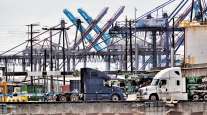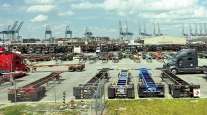Chassis Providers Tout Equipment Upgrades, but Truckers Offer Mixed Reviews on Progress

This story appears in the June 5 print edition of Transport Topics.
Chassis providers have invested millions into renovating their equipment and buying new units to provide draymen a better experience, but while some trucking executives praise the work, others still haven’t seen the payoff.
The three largest chassis providers — Direct ChassisLink Inc. (DCLI), Flexi-Van Leasing Inc. and Trac Intermodal — embarked on projects to replace bias ply tires with radials, incandescent lights with LEDs, and update the brakes.
Chassis providers contend that radial tires are more durable, improve fuel efficiency and reduce the frequency of flat tires. They also argue that LEDs can last up to twice as long as incandescent lights, or about 11½ years compared with five to seven years.
DCLI told Transport Topics that it has added radial tires to about 14,000 chassis since 2014 and plans to fix about 6,000 each year. It also has bought 7,200 new chassis with radials and LEDs.
DCLI owns about 136,000 marine chassis in the United States.
“Truckers don’t want to come in and get a chassis that’s not in good condition and waste time getting it repaired before they can take it,” DCLI Chief Operating Officer Ron Joseph said. “For truckers, it’s all about turn time, especially with the new electronic logging mandate, they have to maximize their productivity.”
He and Brian Taylor, who became DCLI president June 1, will work to maintain the pace on upgrading the nationwide fleet.
Flexi-Van told Transport Topics that about 25% of its active fleet have new tires, lights or been replaced altogether with new chassis. Flexi-Van has about 130,000 chassis nationwide, including those not on the roadway.
Flexi-Van converts about 6,000 chassis per year to radial tires, like DCLI, and 10,000 units annually to LEDs, the company said.
“The motor carriers and the other users of these assets should expect to receive quality equipment, and we fully support that concept and are doing our best to achieve that and will continue to do so over the years,” Flexi-Van Executive Vice President Phil Connors said.
“We also do a lot of reconditioning — not just sandblasting and painting — but also we’re putting on all new hubs and drums. Many people couldn’t tell the reconditioned ones from the brand new ones once we’re done,” added Pete Shevlino, Flexi-Van’s regional director.
In May, Trac Intermodal announced it has refurbished 30% of its fleet of 17,000 chassis covering the Port of New York and New Jersey, Philadelphia, Baltimore, New England and western New York state. Aside from radials and LEDs, the upgrades consist of new electrical systems, new brakes and new airing systems. The equipment provider also began a project to add radial tires to its fleet in Mobile, Ala., and introduced a premium chassis pool in 20 markets earlier this year. Trac owns about 264,000 chassis nationwide.
“Over the years, we’ve tried to create a dialogue with our motor carriers to determine what’s important to them. And the message was clear: ‘We want better quality.’ That’s why we started our refurbishment project three years ago, beginning in New York and New Jersey,” Trac CEO Keith Lovetro told TT on May 9.
But as the big three chip away at the problem, the trucking community has a mixed reaction.
“It’s like night and day, black and white. It’s such a drastic improvement, even though we still have a long way to go,” said Jeff Bader, president of Golden Carriers Inc., which serves the Port of New York and New Jersey, where many of these projects began.
“These companies are all registered as the responsible party to the U.S. DOT and FHWA, and their safety rating is at risk if some of their chassis are not up to par,” he continued, referring to the Department of Transportation and subagency Federal Highway Administration.
Meanwhile, Golden State Express Inc. President Fred Johring said that he hasn’t seen any chassis with radials or LEDs at the ports of Los Angeles and Long Beach.
“We’re having the same issues we’ve always had: the same flat tires or tread flying off in route or the lights not working. It’s happening as frequently now as in the past,” Johring said, adding that some chassis are 30 years old.
He maintains his own private chassis fleet and uses them on as many as 60% of the hauls to minimize delays to his drivers and to prioritize safety, including most trips longer than 60 miles. But Johring also complained that it’s difficult to persuade customers to pay to use his equipment because the steamship lines traditionally offer chassis at a low rate or for free.
Triple G Express President Randy Guillot told TT that there remains a lot of room for improvement. His drivers dray to and from the Port of New Orleans.
“Some of the providers are giving us better tires, LED lights and better braking systems. It’s just not across the board. It’s hit or miss right now,” Guillot said. “I’m still disappointed that there’s not a consistent plan from the providers to convert their entire fleet over to the type of equipment to be safe on the road.”




